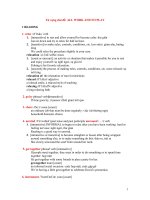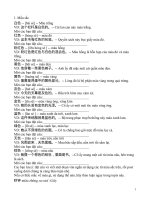Toeic theo chủ đề 7 potx
Bạn đang xem bản rút gọn của tài liệu. Xem và tải ngay bản đầy đủ của tài liệu tại đây (67.99 KB, 6 trang )
22 TOEFL EXAM ESSENTIALS
CHAPTER HIGHLIGHTS
■
Register for the test soon.
■
Organize your current calendar so you can make time to
prepare for the TOEFL exam.
■
Design a study plan and modify it as you go to make it
more useful.
■
Stick to your study plan as much as possible.
■
Time yourself answering practice questions so you can
pace yourself during the exam.
■
Take a standardized practice test on a computer if you
are taking the computer TOEFL exam.
■
Sharpen your computer skills if you are taking the
computer TOEFL exam.
■
Study in an active manner: ask questions, highlight or
underline, make notes.
■
Take steps to reduce your general stress level.
■
Follow strategies to cut down on your test stress.
Adequate test preparation, regular sleep, and good
health habits will increase your confidence and energy.
■
Be prepared: know how to get to the test center and
what materials and documents you will need on test day.
■
Think positively—you are ready for your exam!
Chapter
2
Listening
Y
ou may think of listening as a passive activity, but becom-
ing a good listener means learning to listen actively—to ask
questions, analyze, and draw conclusions about what you
hear. Because lectures and class discussions are the primary teach-
ing methods at universities, good listening skills are crucial for
your success at college.
The listening section of the TOEFL exam measures your abil-
ity to understand North American English. It uses conversa-
tional language including idiomatic expressions, rather than
formal, written English. The section has 30–50 questions and is
40–60 minutes in length. On the exam, you will hear three types
of recordings:
Dialogues: a brief conversation between two people. In some,
each person speaks only once. In others, one or both
23
24 TOEFL EXAM ESSENTIALS
people speak more than once. Each dialogue is followed
by one question.
Short conversations and class discussions: a seven- or
eight-line conversation between two or more people about
a specific topic, followed by several questions.
Mini-lectures: a one- or two-minute talk by a single speaker,
followed by several questions.
Below is a breakdown of each recording type for the computer-
and paper-based TOEFL exams:
Types of Computer Paper-and-
recordings Test Pencil
Dialogues 11–17 dialogues, with 30 dialogues, with
one question each one question each
Short 2–3 conversations, 2 conversations,
Conversations with 2–3 questions with 7–8 questions
each total
Mini-lectures/ 4–6 mini-lectures, with 3 mini-lectures with
Academic 3–6 questions each 12–13 questions total
Discussions
COMPUTER TEST VS. PAPER TEST
The listening section on the computer-based test (CBT) differs
from that on the old, paper-based test. Although you will listen
to the same kinds of conversations and talks, you will answer fewer
questions about each on the CBT. The listening section of the
CBT is also computer adaptive, meaning that the computer
selects questions based on your ability level. Your first question
LISTENING 25
will be of average difficulty. If you answer it correctly, your next
question will be harder. If you answer incorrectly, your next ques-
tion will be easier. Here are some other key differences between
the two tests:
Computer Test: Paper-and-Pencil:
Listening Listening Comprehension
30–50 questions 50 questions
Computer adaptive: Test takers answer the same
questions are based on questions.
your ability.
You wear a headset with Test administrator plays
adjustable volume. recordings.
Includes visuals (pictures Does not include visuals.
and other graphics).
You hear and see the You hear the questions only.
questions on the computer
screen.
You control the pace by You follow the same pace as
choosing when to begin other test takers.
the next recording.
Questions may have two Questions have only one
answers. answer.
Most questions are All questions are multiple
multiple choice, but some choice.
follow special directions.
Once you submit an You can return to previous
answer, you cannot questions and change your
change it. answers.
26 TOEFL EXAM ESSENTIALS
LEARNING HOW TO LISTEN
How can you become a more active listener? Practicing the fol-
lowing listening techniques will improve your ability to under-
stand spoken English:
■
Focus on the speaker. Do not be distracted by your
surroundings or by daydreaming.
■
Use non-verbal responses, like nodding your head or
leaning toward the speaker as you listen. Even if you are
listening to a pre-recorded audiotape for the TOEFL
exam, your physical responses will engage you in the act
of listening and help you concentrate on the
information.
■
Concentrate on the message. If you plan to take the
computer TOEFL exam, you will see pictures of people
on your computer screen before each recording. These
visuals will orient you to the setting and participants of
the conversation, but they may also distract you. Focus
on the conversation, not the picture. If you are taking
the paper-based TOEFL, find a place in the room—a
blank chalkboard or wall—to direct your attention. Do
not be distracted by the reader’s appearance as you listen
to him or her. You may also try closing your eyes as you
listen to the reading of each passage.
SPECIAL TIPS FOR THE COMPUTER TEST
Developers of the computer test use the computer’s multimedia
ability to present different types of questions and to include
LISTENING 27
images along with audio recordings. Other special features of the
computer test include listening to the recordings on your own
headset and controlling your pace throughout the section. To pre-
pare for the computer-based test, try these test-taking strategies:
1. Adjust the volume on your headset before you begin
the listening section. Make sure that you can hear the
recordings clearly. You will not be allowed to adjust the
volume once the testing begins.
2. Don’t be distracted by the computer images of
people. Before most dialogues, your computer screen
will show a picture of the people in the conversation
you are listening to. These images are meant to set the
scene. However, if you find them distracting, look at
them briefly, then close your eyes when you listen to
the recording.
3. Pay close attention to other visuals. Images of maps,
tables or charts, graphs, drawings, or objects may
accompany longer talks and conversations. These
visuals contain information from the talk—information
that you need to answer the questions.
4. Read the questions on your computer screen as you
listen to them. This can help you better understand
them.
5. Pace yourself. Because you control how fast or slow
you go through the test, make sure to keep track of
time. Give yourself enough time to hear each recording
and answer every question.









